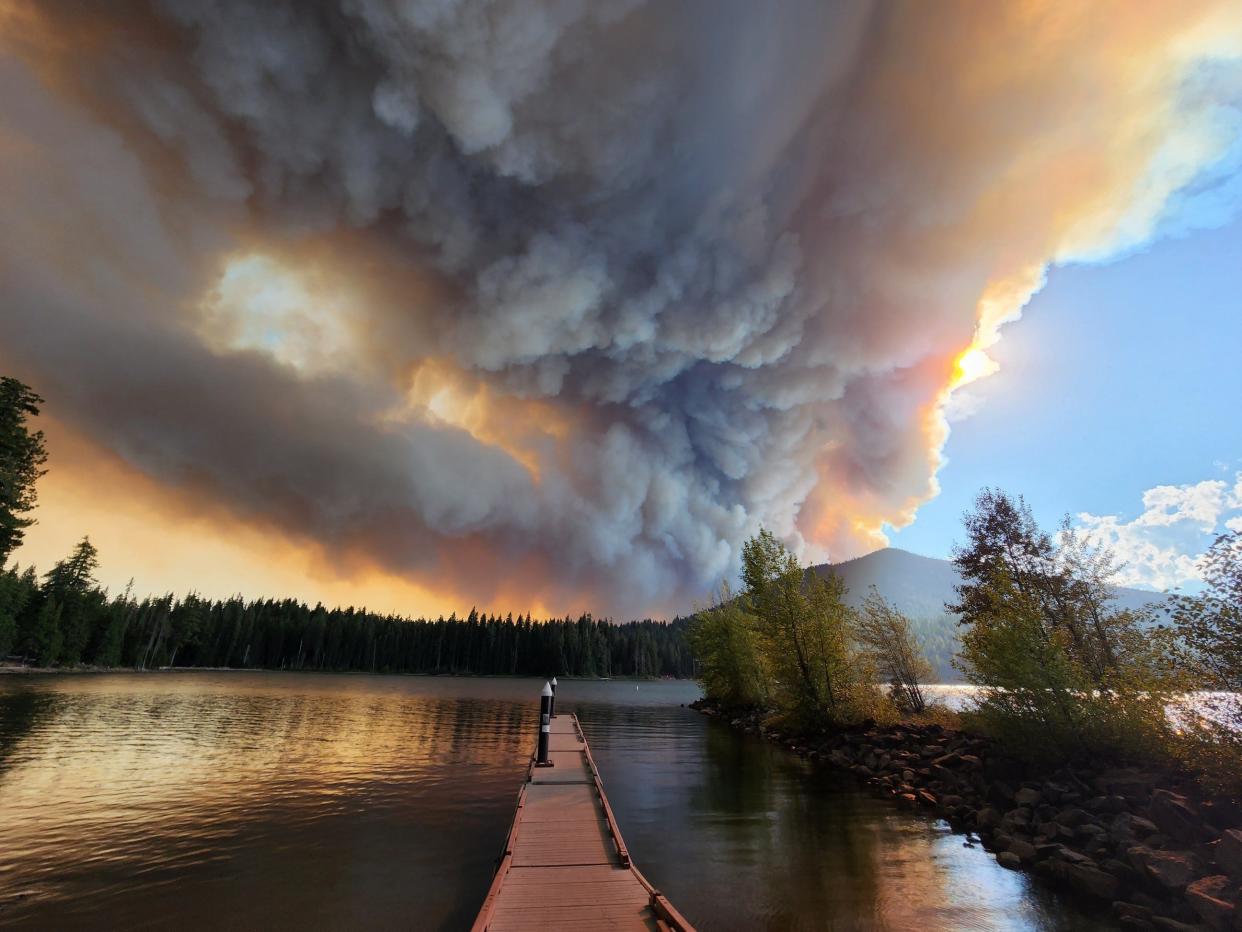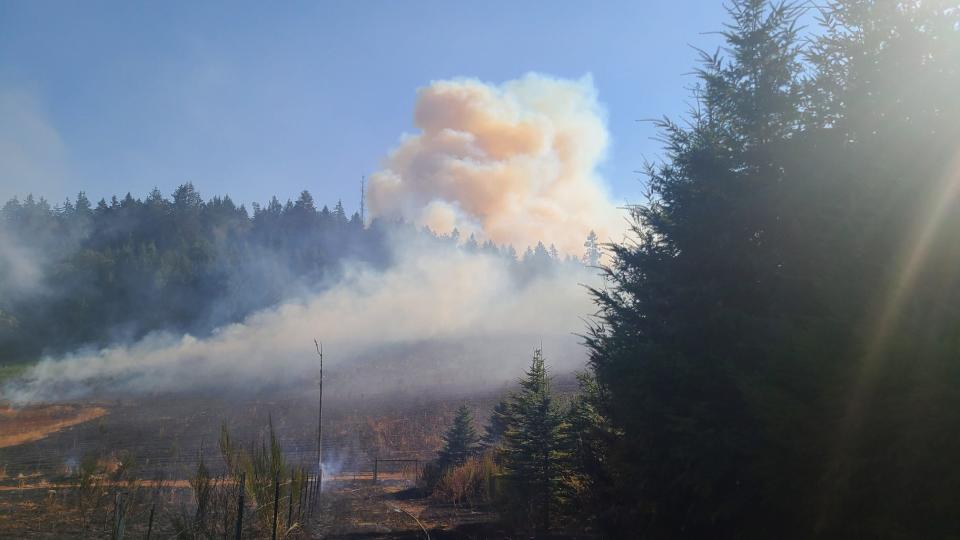'Started late and went long': Even in quieter season, wildfire impact felt across Oregon

By just about every measure, Oregon had a quieter wildfire season in 2022 than recent years and the last decade.
Wildfires burned roughly 442,366 acres this season — far less than the previous two years — while the number of days with poor air quality and buildings lost to fires also declined, according to state and federal data.
Wildfires burned more than 820,000 acres in 2021 and more than 1 million acres in 2020.
Yet to call this fire season “mild” would miss the point. Extreme fire danger brought widespread power shutoffs in early September while urban infernos evacuated hundreds in Salem and Estacada.
Smoky skies, though less numerous than the previous two years, canceled high school sports into late October while residents in Oakridge endured nearly 40 days of poor air quality due to smoke from the 127,283-acre Cedar Creek Fire.
It was a mellow year compared to recent history. Measured against anything pre-2010, though, and it stands out as a significant fire season.
A fire season that started late and wouldn't end
The fire season was slow to start in 2022, following a wetter-than-normal May and June. But once the season got rolling, firefighters in Oregon stayed busy. July to September was the state's hottest in recorded history. The Northwest also saw the most lightning strikes since 2014, leading to numerous small fires in remote locations, particularly the southern Cascade Range.
Federal and state firefighters, bolstered by increased funding, answered with a success rate of more than 96% at suppressing wildfires before they grew above 10 acres, which kept Oregon largely smoke-free during summer. But it came at a cost: Two firefighters died in action — both killed by falling trees — to bring Oregon’s wildland firefighter death count to four since 2020.
And the fire season simply refused to end. A strong east wind event in early September — a weather pattern similar to what led to the 2020 Labor Day fires — put a blast furnace on every active wildfire and sparked new blazes, including in South Salem. Many of the largest fires smoldered across a hot and dry autumn.
Overall, though, experts said this season could easily have been worse.
"With the combination of drought, lightning activity and east winds, the season we had wasn't the worst possible outcome," Oregon State climatologist Larry O'Neill said.
Fire season officially ended Oct. 29 following widespread rain and mountain snow across the state, the Oregon Department of Forestry said in a news release.
Oregon’s wildfires by the numbers
More than half of Oregon’s acres burned came in two megafires. The Double Creek Fire in northeast Oregon, outside Enterprise, burned 171,532 acres while the Cedar Creek Fire near Oakridge burned 127,283, according to data from the Northwest Interagency Coordination Center in Portland.
Of the 442,366 acres burned this year, lightning ignited 874 fires resulting in 379,255 acres burned, while humans caused 843 fires resulting in 42,824 acres burned. Another 267 fires resulting in 20,287 acres burned remain undetermined or under investigation.
This year’s total burned is well below Oregon’s 10-year average of 714,215 acres per year. But it’s also well above the 10-year totals of previous periods.
For example, from 1992 to 2001, Oregon wildfires burned an average of 198,000 acres per year, according to the NWCC. In the years between 2002 and 2017, that number jumped to an average of 433,541 acres burned each year.
Air quality continues to be a problem
While the worst spot for air quality in Oregon this year was Oakridge by far, Eugene also struggled, with eight days of air quality classified as “unhealthy for sensitive groups” or worse, according to the Oregon Department of Environmental Quality.
Portland and Salem had three days at that level, while Medford had six, Bend had five and Enterprise had seven.

For the most part, wildfire smoke was far milder than a year or two years ago, when more than seven cities recorded double-digit days of degraded air quality.
"Oakridge took the brunt of poor air quality brought by wildfire this year, (while) other parts of Oregon saw some relief in comparison to recent smoky summers," said Dylan Darling, spokesman for Oregon DEQ.
Number of homes lost to wildfires declines
Oregon lost at least 11 homes and 53 minor structures in wildfires this year, down from 174 in 2021 and 4,009 during 2020’s Labor Day fires.
Homes and structures destroyed by Oregon wildfires by the year:
2022: 64 (11 homes and 53 other/minor structures)
2021: 174
2020: 4,009
2019: 2
2018: 14
2017: 16
2016: 1
2015: 60
The most destructive fire this year was the 10,800-acre Miller Road Fire outside Maupin, which burned six homes and 34 minor structures, while the Van Meter Fire outside Klamath Falls took two homes and 11 minor structures. The 21,347-acre Rum Creek Fire — which nearly burned the town of Galice in southern Oregon — took two homes and six minor structures.
Cost of suppressing wildfire down slightly
The cost of fighting Oregon’s large wildfires was an estimated $307.6 million this year, according to NWCC. That number won’t be finalized until year’s end, and isn't a perfect representation of costs, but it does capture a snapshot of the millions spent on fire suppression.
Last year, wildfire costs reached a record $607.5 million in Oregon.
This year’s most expensive fire to fight was Cedar Creek, which cost an estimated $132 million so far, while southern Oregon's Rum Creek Fire cost around $55 million.
Increased funding bolsters firefighting
In both Oregon and across the United States, a record-setting amount of money was available to fight wildfires this year following passage of national and state investments.
Federal and state firefighters said that money helped suppress and keep small almost every wildfire that popped up, especially in the Cascade Range this summer.
“This year we had a lot of small fires, from a lot of lightning, but because of the late-season rain and the resources we had, we had a really high success rate at keeping them small,” said Alex Robertson, regional fire director for the U.S. Forest Service. “We had days where multiple crews were putting out multiple fires in one day.”
Only the Cedar Creek Fire, in a remote part of the Waldo Lake Wilderness, escaped an initial attempt to put it out and become a long-term fire in the Cascade Range.
Initially, Cedar Creek wasn’t expected to grow in a major way and, at least in the beginning, was bringing a healthy low-severity fire to an area that needed it, officials said. Even with the fire, the popular Waldo Lake area stayed open much of the summer. That changed in early September when east winds caused the fire to explode and make a run toward Oakridge.
Oregon’s firefighting force, which got a boost in funds and equipment from passage of wildfire legislation in 2021, highlighted its investments in early detection methods to help keep fires quiet this year.
ODF credited its remote camera detection system — which added new cameras on the tops of mountains statewide — for spotting 57 fires in the southwest part of the state. In addition, it highlighted its multi-mission aircraft for spotting another 56 fires in remote locations, the agency said.
“We were fortunate this year to have adequate resources to respond to fires in our jurisdiction while also being able to send resources to our partner agencies to help in their firefighting efforts,” ODF fire protection division deputy chief Ron Graham said.
Read more: 'Digital fire lookouts' watch horizon on remote cameras for signs of wildfire
Two firefighters killed by falling trees
While firefighters did have success in suppressing the vast majority of wildfires this season, it came at a cost. Two firefighters were killed when they were hit by falling trees.
Logan Taylor, 25, of Talent, was critically injured in mid-August after being struck by a tree on the Rum Creek Fire, located north of Galice and above the Rogue River in southwest Oregon.
Collin Hagan, a hot shot firefighter from Colorado, died Aug. 10 after being struck by a tree on the Big Swamp Fire burning near Oakridge.
Robertson said that along with the two fatal accidents, there were other close calls this season.
"It's a hazardous profession," he said. "We were fighting fire in some unforgiving landscapes. The sweet spot is looking for fires where we're going to have the best chance of success while not putting people in dangerous places, or in places where if there's an injury, we can't get them out.
"It's always a calculated risk. But the only way to eliminate the risk is to not go in, and that's not an option for us."
In August 2021, Frumencio Ruiz Carapia, 56, who was working on the eastern edge of the Gales Fire, also near Oakridge, died when he was hit by a tree.
In August 2020, Thomas Duffy, 40, a pilot who was dropping water on the White River Fire near Mount Hood, died when his helicopter crashed.
East wind event brings power shutoffs, urban wildfires, extreme growth

Through July and August, Oregon’s fire season was as quiet as it had been since 2019, when only 68,000 acres burned the entire year.
That changed in a hurry with the arrival of a powerful east wind event. The hot and dry winds are synonymous with major wildfire growth and since they arrived during a prolonged dry spell, they brought fire danger to extreme limits.
Oregon’s utilities responded by cutting power to 50,000 homes and businesses, in the hopes of reducing the threat of wildfires ignited from downed power lines.
Related: Has Oregon entered a new era of power shutoffs due to rising wildfire threat?
Even so, the fast-growing Cedar Creek Fire brought level 3 evacuations to Oakridge. Meanwhile, in urban areas, the Vitae Springs Fire ignited in South Salem and brought widespread evacuations before burning 167 areas. To the north, near Milo McIver State Park outside Estacada, the McIver Fire burned more than 30 acres and burned down one home.
The moment stressed the growing concern about urban wildfires igniting in forested areas in Willamette Valley cities that the Statesman Journal highlighted last summer.
“For Oregon, urban-suburban wildfires are no longer a hypothetical situation," Andrew Phelps, director of Oregon Office of Emergency Management, told the Statesman Journal last year. "We've got very real, tangible examples.”
The east wind event meant that almost overnight, Oregon’s non-existent wildfire season kicked into high gear. The winds eventually moderated, dropping fire danger, but the state stayed hot and dry throughout September and October, allowing the fires to burn longer than normal.
Simply put, 2022 was a year when fire season “started late and went long,” Robertson said.
Explore Oregon Podcast: Why are east winds fueling wildfires in Oregon?
Largest and most expensive wildfires of 2022
1: Double Creek
Size: 171,532 acres
Cost: $39.5 million
Cause: Lightning
Location: 25 miles east of Enterprise
Structures lost: 3
2: Cedar Creek
Size: 127,283 acres
Cost: $132,730,000
Cause: Lightning
Location: 15 miles east of Oakridge
Structures lost: 0
3: Willow Creek
Size: 40,274 acres
Cost: $285,000
Cause: Human
Location: 12 miles north of Vale
Structures lost: 0
4: Sturgill
Size: 23,162 acres
Cost: $4,575,000
Cause: Lightning
Location: 15 miles southwest of Enterprise
Structures lost: 0
5: Rum Creek
Size: 21,347 acres
Cost: $55.2 million
Cause: Lightning
Location: Rand
Structures lost: 8
6: Nebo
Size: 12,609 acres
Cost: $2.2 million
Cause: Lightning
Location: 21 miles southeast of Enterprise
Structures lost: 0
7: Miller Road
Size: 10,847 acres
Cost: $3,917,366
Cause: Undetermined
Location: 8 miles southwest of Maupin
Structures lost: 40
8: Jim Creek
Size: 4,429 acres
Cost: $1,000
Cause: Lightning
Location: 2 miles southeast of Jim Creek Butte Area
Structures lost: 0
9: Jones Creek
Size: 4,429 acres
Cost: $1.4 million
Cause: Undetermined
Location: 50 miles southeast of Lewiston, Idaho
Structures lost: 0
10: Crockets Knob
Size: 4,331 acres
Cost: $18 million
Cause: Lightning
Location: 19 miles north of Prairie City
Structures lost: 0
11: Amelia Road
Size: 3,238 acres
Cost: $400,000
Cause: Undetermined
Location: 12 miles northwest of Brogan
Structures lost: 0
12: Van Meter
Size: 2,639 acres
Cost: $5,310,000
Cause: Undetermined
Location: 13 miles southwest of Klamath Falls
Structures lost: 13
13: Vines Hill
Size: 2,428 acres
Cost: $50,000
Cause: Lightning
Location: 6 miles east of Harper
Structures lost: 0
Zach Urness has been an outdoors reporter in Oregon for 15 years and is host of the Explore Oregon Podcast. To support his work, subscribe to the Statesman Journal. Urness is the author of “Best Hikes with Kids: Oregon” and “Hiking Southern Oregon.” He can be reached at zurness@StatesmanJournal.com or 503-399-6801. Find him on Twitter at @ZachsORoutdoors.
This article originally appeared on Salem Statesman Journal: Even in quieter season, wildfire impact felt across Oregon

